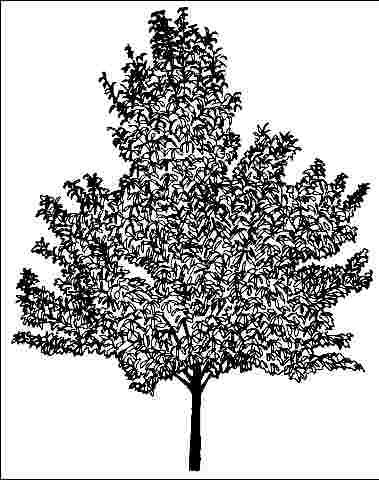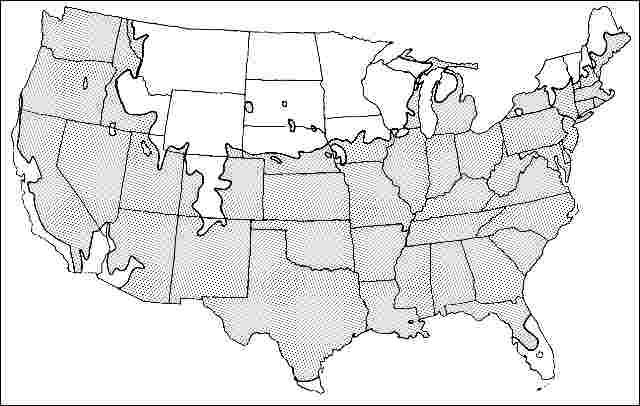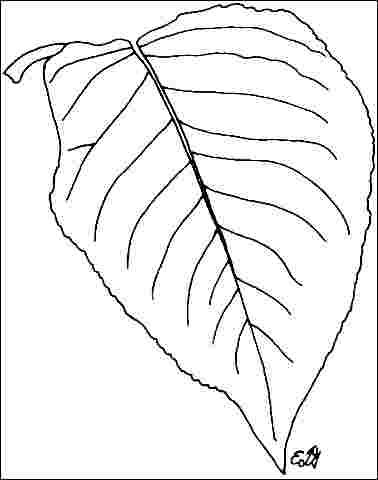Introduction
`Aristocrat' Callery Pear quickly grows 35 to 45 feet high and 30 to 35 feet wide, with widely-spaced, upright-spreading, thornless branches. The more dominant trunk and open form of `Aristocrat' Callery Pear helps to make it less susceptible to wind and ice damage than `Bradford'. Branch angles are wider and lateral branches grow at a slower rate than on `Bradford', therefore the branches are better attached to the trunk. In spring before the new leaves unfold, the tree puts on a brilliant display of pure white flowers which, unfortunately, do not have a pleasant fragrance. The leaves emerge as red/purple, then become 1.5 to 3 inches long, glossy green with wavy margins and a red blush. They turn red again in fall before dropping. The small, pea-sized, red/brown fruits which form are quite attractive to birds and other wildlife, and mummify on the tree persisting for several months to a year. Planting two or more cultivars of Callery Pear together could increase fruit set.

General Information
Scientific name: Pyrus calleryana
Pronunciation: PIE-rus kal-ler-ee-AY-nuh
Common name(s): 'Aristocrat' Callery Pear
Family: Rosaceae
USDA hardiness zones: 5A through 9A (Fig. 2)
Origin: not native to North America
Invasive potential: little invasive potential
Uses: shade; street without sidewalk; container or planter; screen; specimen; parking lot island < 100 sq ft; parking lot island 100-200 sq ft; parking lot island > 200 sq ft; sidewalk cutout (tree pit); tree lawn 3-4 feet wide; tree lawn 4-6 feet wide; tree lawn > 6 ft wide; urban tolerant; highway median
Availability: not native to North America

Description
Height: 35 to 45 feet
Spread: 25 to 35 feet
Crown uniformity: irregular
Crown shape: pyramidal
Crown density: moderate
Growth rate: fast
Texture: medium
Foliage
Leaf arrangement: alternate (Fig. 3)
Leaf type: simple
Leaf margin: undulate, sinuate/undulate, crenate
Leaf shape: ovate
Leaf venation: pinnate, reticulate
Leaf type and persistence: deciduous
Leaf blade length: less than 2 inches, 2 to 4 inches
Leaf color: green
Fall color: red
Fall characteristic: showy

Flower
Flower color: white/cream/gray
Flower characteristics: very showy
Fruit
Fruit shape: round
Fruit length: less than .5 inch
Fruit covering: dry or hard
Fruit color: brown, tan
Fruit characteristics: attracts birds; not showy; fruit/leaves not a litter problem
Trunk and Branches
Trunk/bark/branches: branches droop; not showy; typically one trunk; thorns
Pruning requirement: needed for strong structure
Breakage: resistant
Current year twig color: brown
Current year twig thickness: thick
Wood specific gravity: unknown
Culture
Light requirement: full sun
Soil tolerances: clay; sand; loam; alkaline; acidic; occasionally wet; well-drained
Drought tolerance: high
Aerosol salt tolerance: moderate
Other
Roots: not a problem
Winter interest: no
Outstanding tree: no
Ozone sensitivity: tolerant
Verticillium wilt susceptibility: resistant
Pest resistance: sensitive to pests/diseases
Use and Management
Planted commonly as a street tree or in parking lot islands, it is also quite suited for downtown tree pits due to its urban tolerance. Like `Bradford' pear, it is able to tolerate small soil spaces. It looks great located along a street on 20 to 25-foot-centers and creates a `corridor' for traffic flow.
The major problem with the `Bradford' pears has been too many upright branches growing too closely together on the trunk which leads to branch breakage and splitting. `Aristocrat' appears to be mostly free of this problem, but has been shown to be more susceptible to fire blight than `Bradford', particularly in evaluations conducted in the south. Pruning the trees early in their life to space lateral branches along a central trunk should be all that is needed to ensure a strong, well-structured tree. Only buy trees with well-spaced branches.
Callery Pear trees are shallow-rooted and will tolerate most soil types including alkaline and clay, are pollution-resistant and tolerate drought and wet soil well. `Aristocrat' is a very adaptable tree suited for downtown and other restricted soil spaces.
Pests
Aphids cause distorted growth and deposits of honeydew.
Scales occasionally affect pears.
Several borers may attack pear. Keep trees healthy to prevent attacks.
Diseases
`Aristocrat' pear is very susceptible to fire blight. This disease can devastate a planting. Tips of infected branches appear scorched and burnt. The leaves droop, turn brown, but remain hanging on the tree. The bacteria wash down the branch and form cankers. Bark inside the canker often shreds and peels. When a canker girdles a branch, that branch dies. Prune out infected branches well below the infected area.